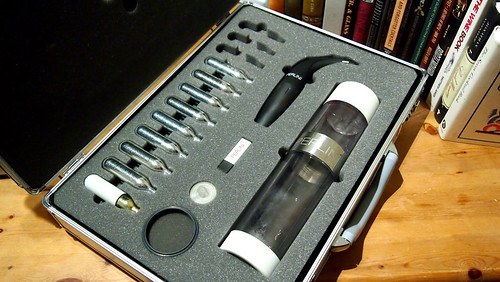For your money, you get a suitcase that bears a passing resemblance to those handcuffed to secret agents in movies containing a the mutant child of a bell jar, a T-Virus canister, and a three-piece shaker, and a small black gadget that holds a 16g CO2 charger and looks kind of like a sex toy. There's a one-way valve built into the top of the shaker and the process is simple enough: shake your drink as normal and then feed the carbon dioxide into the shaker. Leave for 30 secs and all of sudden, you have fizzy cocktails.
Carbonating cocktails is undoubtedly fun but while a fizzy daiquiri tastes equal parts of amazing and uncanny, I don't know if it's much more than a novelty and it took a while for me to happen upon a good reason to use the technique. Sloane's Gin had started up a cocktail competition and were asking for entries based on the idea of "twisted traditions" and I chose the Gin & Tonic as the tradition I wanted to play with.
It wasn't a totally random choice: Sloane's Gin is named for Sir Hans Sloane, the first medical practitioner in Britain to be granted a hereditary title, a former president of both the Royal College of Physicians and the Royal Society, and doctor to three successive monarchs (Queen Anne, George I and George II) and that fitted in well with gin's origins as medicine. I also remembered that while British colonists were partial to tonic water as their preferred preventative against malaria, French colonists would turn to aperitif wines such as Byrrh and Lillet to get their fix of quinine. The idea came together pretty quickly after that: combine the British - gin - with the French - tonic wine - and use carbonation to present something that's reminiscent of a classic Gin & Tonic but at the same time something new as well.
French Tonic
35ml Sloane's Dry Gin
25ml Lillet Blanc
15ml lemon juice
10ml sugar syrup
Combine all ingredients in Perlini shaker; shake with ice; charge with CO2 and reserve for ~30 seconds. Strain into an ice-filled highball and garnish with a twist of orange zest and a twist of lemon zest.
There are a couple of interesting foibles to this recipe; for one, I've generally found that I've had to make drinks a little sweeter than I normally would before carbonating them (hence the 10ml of sugar syrup) and that seems to be down to the carbon dioxide itself. The citrus flavours of Lillet Blanc work really well with the botanicals in Sloane's and provide a nice counterpoint to its dominant vanilla note.
The carbonation is the key part of the drink. It allows me to present something that plays on our expectation of an instantly recognisable drink and that's always an interesting area to play around in. The Perlini system isn't the only way to make drinks fizzy - honestly, it might not be the best way, particularly if you're planning on making them in any great volume but it's turning into a useful tool for me to broaden my horizons.





